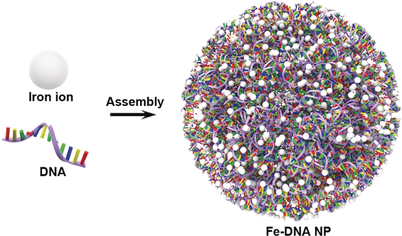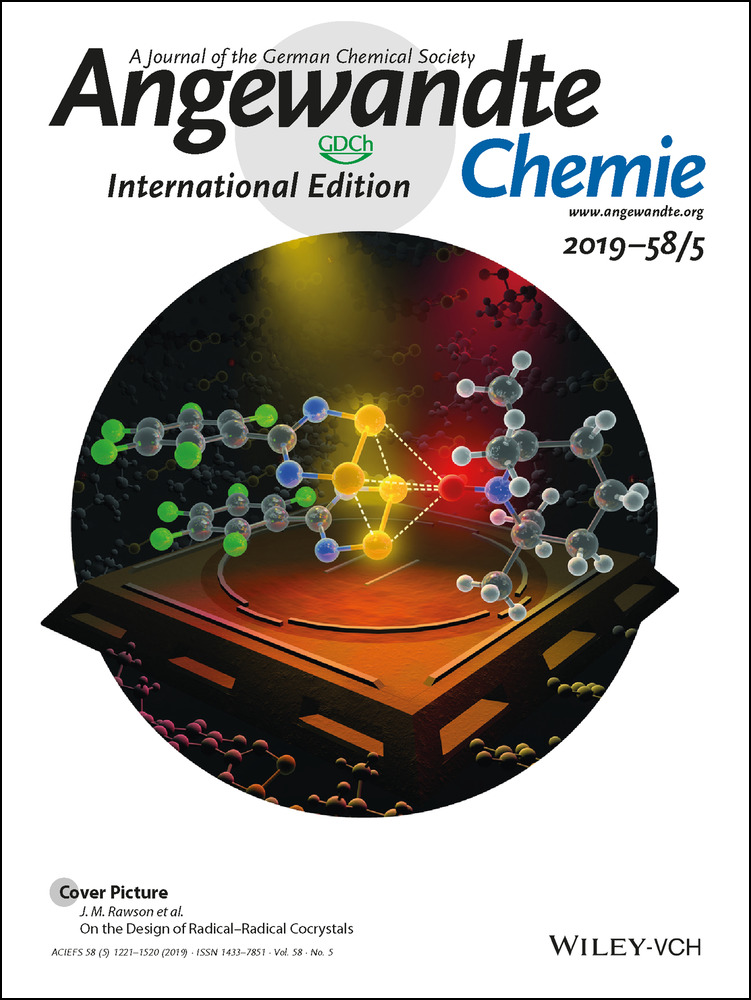Engineering Multifunctional DNA Hybrid Nanospheres through Coordination-Driven Self-Assembly
Dr. Mengyuan Li
CAS Key Laboratory for Biomedical Effects of Nanomaterials, and Nanosafety and CAS Center for Excellence in Nanoscience, National Center for Nanoscience and Technology, Beijing, 100190 China
College of Chemistry and Molecular Engineering, Peking University, Beijing, 100871 China
These authors contributed equally to this work.
Search for more papers by this authorCongli Wang
CAS Key Laboratory for Biomedical Effects of Nanomaterials, and Nanosafety and CAS Center for Excellence in Nanoscience, National Center for Nanoscience and Technology, Beijing, 100190 China
University of Chinese Academy of Sciences, Beijing, 100049 China
These authors contributed equally to this work.
Search for more papers by this authorZhenghan Di
CAS Key Laboratory for Biomedical Effects of Nanomaterials, and Nanosafety and CAS Center for Excellence in Nanoscience, National Center for Nanoscience and Technology, Beijing, 100190 China
University of Chinese Academy of Sciences, Beijing, 100049 China
These authors contributed equally to this work.
Search for more papers by this authorHui Li
Department of Chemistry and Chemical Biology, Northeastern University, Boston, MA, 02115 USA
Search for more papers by this authorJingfang Zhang
CAS Key Laboratory for Biomedical Effects of Nanomaterials, and Nanosafety and CAS Center for Excellence in Nanoscience, National Center for Nanoscience and Technology, Beijing, 100190 China
Search for more papers by this authorWenting Xue
CAS Key Laboratory for Biomedical Effects of Nanomaterials, and Nanosafety and CAS Center for Excellence in Nanoscience, National Center for Nanoscience and Technology, Beijing, 100190 China
Search for more papers by this authorProf. Meiping Zhao
College of Chemistry and Molecular Engineering, Peking University, Beijing, 100871 China
Search for more papers by this authorProf. Ke Zhang
Department of Chemistry and Chemical Biology, Northeastern University, Boston, MA, 02115 USA
Search for more papers by this authorProf. Yuliang Zhao
CAS Key Laboratory for Biomedical Effects of Nanomaterials, and Nanosafety and CAS Center for Excellence in Nanoscience, National Center for Nanoscience and Technology, Beijing, 100190 China
University of Chinese Academy of Sciences, Beijing, 100049 China
Search for more papers by this authorCorresponding Author
Prof. Lele Li
CAS Key Laboratory for Biomedical Effects of Nanomaterials, and Nanosafety and CAS Center for Excellence in Nanoscience, National Center for Nanoscience and Technology, Beijing, 100190 China
University of Chinese Academy of Sciences, Beijing, 100049 China
Search for more papers by this authorDr. Mengyuan Li
CAS Key Laboratory for Biomedical Effects of Nanomaterials, and Nanosafety and CAS Center for Excellence in Nanoscience, National Center for Nanoscience and Technology, Beijing, 100190 China
College of Chemistry and Molecular Engineering, Peking University, Beijing, 100871 China
These authors contributed equally to this work.
Search for more papers by this authorCongli Wang
CAS Key Laboratory for Biomedical Effects of Nanomaterials, and Nanosafety and CAS Center for Excellence in Nanoscience, National Center for Nanoscience and Technology, Beijing, 100190 China
University of Chinese Academy of Sciences, Beijing, 100049 China
These authors contributed equally to this work.
Search for more papers by this authorZhenghan Di
CAS Key Laboratory for Biomedical Effects of Nanomaterials, and Nanosafety and CAS Center for Excellence in Nanoscience, National Center for Nanoscience and Technology, Beijing, 100190 China
University of Chinese Academy of Sciences, Beijing, 100049 China
These authors contributed equally to this work.
Search for more papers by this authorHui Li
Department of Chemistry and Chemical Biology, Northeastern University, Boston, MA, 02115 USA
Search for more papers by this authorJingfang Zhang
CAS Key Laboratory for Biomedical Effects of Nanomaterials, and Nanosafety and CAS Center for Excellence in Nanoscience, National Center for Nanoscience and Technology, Beijing, 100190 China
Search for more papers by this authorWenting Xue
CAS Key Laboratory for Biomedical Effects of Nanomaterials, and Nanosafety and CAS Center for Excellence in Nanoscience, National Center for Nanoscience and Technology, Beijing, 100190 China
Search for more papers by this authorProf. Meiping Zhao
College of Chemistry and Molecular Engineering, Peking University, Beijing, 100871 China
Search for more papers by this authorProf. Ke Zhang
Department of Chemistry and Chemical Biology, Northeastern University, Boston, MA, 02115 USA
Search for more papers by this authorProf. Yuliang Zhao
CAS Key Laboratory for Biomedical Effects of Nanomaterials, and Nanosafety and CAS Center for Excellence in Nanoscience, National Center for Nanoscience and Technology, Beijing, 100190 China
University of Chinese Academy of Sciences, Beijing, 100049 China
Search for more papers by this authorCorresponding Author
Prof. Lele Li
CAS Key Laboratory for Biomedical Effects of Nanomaterials, and Nanosafety and CAS Center for Excellence in Nanoscience, National Center for Nanoscience and Technology, Beijing, 100190 China
University of Chinese Academy of Sciences, Beijing, 100049 China
Search for more papers by this authorGraphical Abstract
Abstract
Developing simple and general approaches for the synthesis of nanometer-sized DNA materials with specific morphologies and functionalities is important for various applications. Herein, a novel approach for the synthesis of a new set of DNA-based nanoarchitectures through coordination-driven self-assembly of FeII ions and DNA molecules is reported. By fine-tuning the assembly, Fe–DNA nanospheres of precise sizes and controlled compositions can be produced. The hybrid nanoparticles can be tailored for delivery of functional DNA to cells in vitro and in vivo with enhanced biological function. This highlights the potential of metal ion coordination as a tool for directing the assembly of DNA architectures, which conceptualizes a new pathway to expand the repertoire of DNA-based nanomaterials. This methodology will advance both the fields of DNA nanobiotechnology and metal–ligand coordination chemistry.
Supporting Information
As a service to our authors and readers, this journal provides supporting information supplied by the authors. Such materials are peer reviewed and may be re-organized for online delivery, but are not copy-edited or typeset. Technical support issues arising from supporting information (other than missing files) should be addressed to the authors.
| Filename | Description |
|---|---|
| anie201810735-sup-0001-misc_information.pdf2.3 MB | Supplementary |
Please note: The publisher is not responsible for the content or functionality of any supporting information supplied by the authors. Any queries (other than missing content) should be directed to the corresponding author for the article.
References
- 1
- 1aY. J. Chen, B. Groves, R. A. Muscat, G. Seelig, Nat. Nanotechnol. 2015, 10, 748–760;
- 1bS. M. Douglas, I. Bachelet, G. M. Church, Science 2012, 335, 831–834;
- 1cR. Mo, T. Jiang, R. DiSanto, W. Tai, Z. Gu, Nat. Commun. 2014, 5, 3364;
- 1dJ. B. Lee, J. Hong, D. K. Bonner, Z. Poon, P. T. Hammond, Nat. Mater. 2012, 11, 316–322.
- 2
- 2aD. Luo, W. M. Saltzman, Nat. Biotechnol. 2000, 18, 33–37;
- 2bD. Putnam, Nat. Mater. 2006, 5, 439–451.
- 3
- 3aN. C. Seeman, J. Theor. Biol. 1982, 99, 237–247;
- 3bN. C. Seeman, Annu. Rev. Biochem. 2010, 79, 65–87;
- 3cP. W. K. Rothemund, Nature 2006, 440, 297–302;
- 3dS. M. Douglas, H. Dietz, T. Liedl, B. Hogberg, F. Graf, W. M. Shih, Nature 2009, 459, 414–418;
- 3eF. A. Aldaye, A. L. Palmer, H. F. Sleiman, Science 2008, 321, 1795–1799;
- 3fD. Han, S. Pal, J. Nangreave, Z. Deng, Y. Liu, H. Yan, Science 2011, 332, 342–346;
- 3gY. Ke, L. L. Ong, W. M. Shih, P. Yin, Science 2012, 338, 1177–1183.
- 4
- 4aC. A. Mirkin, R. L. Letsinger, R. C. Mucic, J. J. Storhoff, Nature 1996, 382, 607–609;
- 4bJ. I. Cutler, E. Auyeung, C. A. Mirkin, J. Am. Chem. Soc. 2012, 134, 1376–1391;
- 4cM. R. Jones, N. C. Seeman, C. A. Mirkin, Science 2015, 347, 1260901.
- 5
- 5aC. Lu, Z. Huang, B. Liu, Y. Liu, Y. Ying, J. Liu, Angew. Chem. Int. Ed. 2017, 56, 6208–6212; Angew. Chem. 2017, 129, 6304–6308;
- 5bT. Song, L. Tang, L. Tan, X. Wang, N. S. R. Satyavolu, H. Xing, Z. Wang, J. Li, H. Liang, Y. Lu, Angew. Chem. Int. Ed. 2015, 54, 8114–8118; Angew. Chem. 2015, 127, 8232–8236;
- 5cB. Liu, Z. Huang, J. Liu, Angew. Chem. Int. Ed. 2018, 57, 9439–9442; Angew. Chem. 2018, 130, 9583–9586.
- 6
- 6aS. Leininger, B. Olenyuk, P. J. Stang, Chem. Rev. 2000, 100, 853–908;
- 6bS. Datta, M. L. Saha, P. J. Stang, Acc. Chem. Res. 2018, 51, 2047–2063.
- 7
- 7aM. Oh, C. A. Mirkin, Nature 2005, 438, 651–654;
- 7bW. Lin, W. J. Rieter, K. M. L. Taylor, Angew. Chem. Int. Ed. 2009, 48, 650–658; Angew. Chem. 2009, 121, 660–668;
- 7cI. Imaz, J. Hernando, D. Ruiz-Molina, D. Maspoch, Angew. Chem. Int. Ed. 2009, 48, 2325–2329; Angew. Chem. 2009, 121, 2361–2365;
- 7dR. Kaminker, R. Popovitz-Biro, M. E. van der Boom, Angew. Chem. Int. Ed. 2011, 50, 3224–3226; Angew. Chem. 2011, 123, 3282–3284;
- 7eC. He, D. Liu, W. Lin, Chem. Rev. 2015, 115, 11079–11108;
- 7fJ. G. Heck, J. Napp, S. Simonato, J. Möllmer, M. Lange, H. M. Reichardt, R. Staudt, F. Alves, C. Feldmann, J. Am. Chem. Soc. 2015, 137, 7329–7336;
- 7gH. Ejima, J. J. Richardson, K. Liang, J. P. Best, M. P. van Koeverden, G. K. Such, J. Cui, F. Caruso, Science 2013, 341, 154–157;
- 7hJ. Guo, Y. Ping, H. Ejima, K. Alt, M. Meissner, J. J. Richardson, Y. Yan, K. Peter, D. von Elverfeldt, C. E. Hagemeyer, F. Caruso, Angew. Chem. Int. Ed. 2014, 53, 5546–5551; Angew. Chem. 2014, 126, 5652–5657;
- 7iZ. Fan, L. Sun, Y. Huang, Y. Wang, M. Zhang, Nat. Nanotechnol. 2016, 11, 388–394.
- 8
- 8aH. Furukawa, K. E. Cordova, M. O'Keeffe, O. M. Yaghi, Science 2013, 341, 1230444;
- 8bH. C. Zhou, S. Kitagawa, Chem. Soc. Rev. 2014, 43, 5415–5418;
- 8cS. Wang, C. M. McGuirk, A. d'Aquino, J. A. Mason, C. A. Mirkin, Adv. Mater. 2018, 30, 1800202.
- 9A. V. Zhukhovitskiy, M. Zhong, E. G. Keeler, V. K. Michaelis, J. E. P. Sun, M. J. A. Hore, D. J. Pochan, R. G. Griffin, A. P. Willard, J. A. Johnson, Nat. Chem. 2015, 8, 33–41.
- 10J. Liu, X. Sun, P. Song, Y. Zhang, W. Xing, W. Xu, Adv. Mater. 2013, 25, 6879–6883.
- 11F. Liu, X. He, H. Chen, J. Zhang, H. Zhang, Z. Wang, Nat. Commun. 2015, 6, 8003.
- 12
- 12aR. B. Martin, Acc. Chem. Res. 1985, 18, 32–38;
- 12bW. Zhou, R. Saran, J. Liu, Chem. Rev. 2017, 117, 8272–8325.
- 13R. Ahmad, H. Arakawa, H. A. Tajmir-Riahi, Biophys. J. 2003, 84, 2460–2466.
- 14D. Miyoshi, H. Karimata, N. Sugimoto, J. Am. Chem. Soc. 2006, 128, 7957–7963.
- 15D. M. Klinman, Nat. Rev. Immunol. 2004, 4, 249–259.





